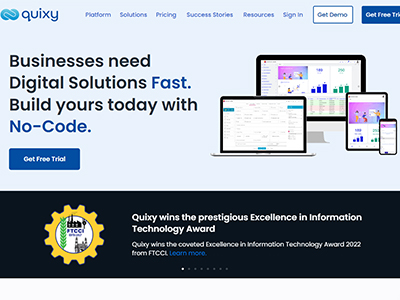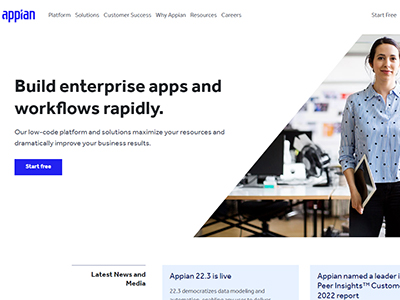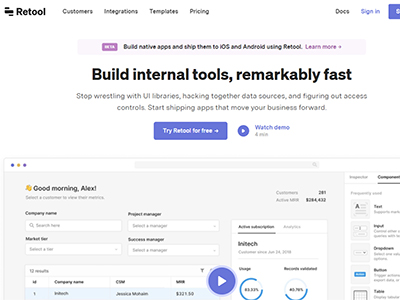Low-Code Development Platforms

5 Useful Low-Code Development Platforms
Low-code development platforms provide developers with a faster, simpler, and more effective way to code and deploy the software they create. They do this through a visual interface that enables automating tasks and minimizing repetitive processes. Low-code platforms target primarily developers and require some amount of technical experience.
If you are looking for a low-code development platform, you’ve come to the right place. Here are 5 useful low-code development platforms you can choose right now. We include information about their features, pricing model, and more.
1. Visual LANSA
 Visual LANSA features a powerful low-code visual software development environment through which you can build apps for the web, mobile, and desktop. It caters to small, medium, and large businesses. Used by thousands of companies worldwide, it speeds up the development of apps for the web, mobile devices, and Windows, Linux, and IBM i servers. You can also use Visual LANSA to build internal applications for intranets.
Visual LANSA features a powerful low-code visual software development environment through which you can build apps for the web, mobile, and desktop. It caters to small, medium, and large businesses. Used by thousands of companies worldwide, it speeds up the development of apps for the web, mobile devices, and Windows, Linux, and IBM i servers. You can also use Visual LANSA to build internal applications for intranets.
Key features
- Powerful and intuitive low-code integrated development environment (IDE)
- Quick app development process
- Easy to get used to
- Lets you write code in the IDE if you need
- Advanced testing and deployment features
Pricing
Free trial available after which you can choose between three different pricing tiers starting at $8.34 a month per user for enterprise solutions.
2. Quixy
 Quixy is a feature-rich no-code development platform you can use to automate software development workflows for web apps and mobile apps. With it, you can start app building from scratch or customize one of the pre-made apps in the Quixy app store. Overall, the platform is easy to work with and provides enough features to appeal not only to small businesses but also to medium-sized companies and enterprises.
Quixy is a feature-rich no-code development platform you can use to automate software development workflows for web apps and mobile apps. With it, you can start app building from scratch or customize one of the pre-made apps in the Quixy app store. Overall, the platform is easy to work with and provides enough features to appeal not only to small businesses but also to medium-sized companies and enterprises.
Key features
- Accessible visual builder makes you build software using different workflows
- Drag-and-drop editor with form fields features over 40 widgets
- Integrates well with third-party applications
- One-click app deployment
- Offline mode works on any browser and device
- Certified for enterprise use
Pricing
Free trial available after which you can choose from multiple pricing plans starting at $10 a month per user (for at least 10 users).
3. Appian
 Appian provides a low code app development environment that simplifies automation. It promises to get apps to market up to 20 times faster while cutting back costs compared to traditional app development. Appian supports many different types of apps including web apps, Windows, Mac, and Linux programs, and more.
Appian provides a low code app development environment that simplifies automation. It promises to get apps to market up to 20 times faster while cutting back costs compared to traditional app development. Appian supports many different types of apps including web apps, Windows, Mac, and Linux programs, and more.
Key features
- Simple and powerful drag-and-drop app development interface
- Robotic process automation can boost productivity
- Scalable development tool lets you build and deploy apps that range from the simple to the complex
- Business process management features
- Case management makes collaborative work and exception handling easier
- Native AI services
Pricing
Free trial after which standard plan costs $90 a month per user.
4. Creatio
 Creatio brings together low-code development with process management features. It comes with an intelligent visual creation platform that supports both structured and unstructured workflows. It also has its own marketplace where you can get ready-made apps.
Creatio brings together low-code development with process management features. It comes with an intelligent visual creation platform that supports both structured and unstructured workflows. It also has its own marketplace where you can get ready-made apps.
Features
- App wizard makes the process of building apps faster and more convenient
- Makes low-code automation easy
- Integrates machine learning and AI tools for analytics and more
- Visual interface that is appealing and easy to work with
- Built-in security features make it a reliable collaborative tool for low-code app development
Pricing
Free 14-day trial available after which pricing starts at $25 a month per user.
5. Retool
 Retool is a low-code platform that enables the development of internal applications. It’s highly customizable as it allows you to switch to code when you need to. It also works with any API or database. It’s used by teams around the world, in companies as large as Amazon.
Retool is a low-code platform that enables the development of internal applications. It’s highly customizable as it allows you to switch to code when you need to. It also works with any API or database. It’s used by teams around the world, in companies as large as Amazon.
Features
- Over 50 drag-and-drop components help you build internal software faster
- Lets you write JavaScript to customize your app
- Works in the cloud as well as a self-hosted solution
- Strong security features including audit logs and access controls
Pricing
Free plan with no creator restrictions available for developers. Team plan starts at $10 a month per user.
Low-Code Development Platforms – The Wrap Up
Choosing the right low-code development platform for you boils down to the features you need. All the top platforms we reviewed provide rich features and make low code development easy. You can try out several platforms before making up your mind about which to choose.
Low-Code Development Platforms – Additional Resources
- Visual LANSA – Make your business engine run smoother and faster with Visual LANSA Hybrid Low-Code platform.
- Quixy – Businesses need Digital Solutions Fast. Build yours today with No-Code.
- Appian – Our low-code platform and solutions maximize your resources and dramatically improve your business results.
- Creatio – One platform to automate workflows and CRM with no-code and a maximum degree of freedom.
- Retool – Build internal tools, remarkably fast
